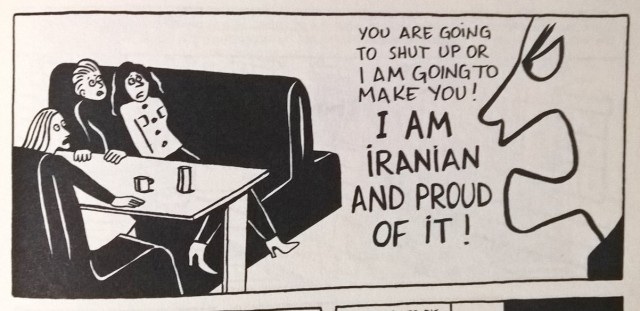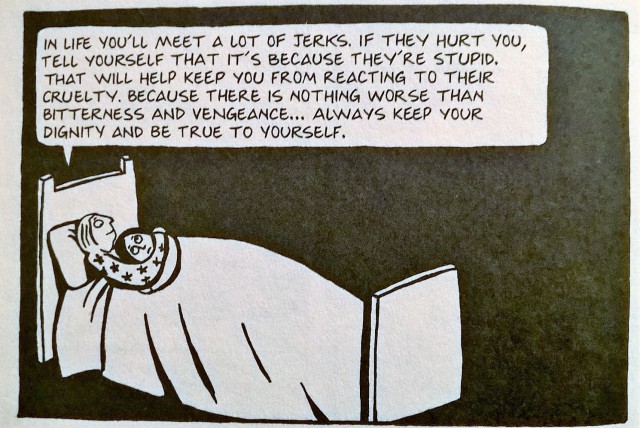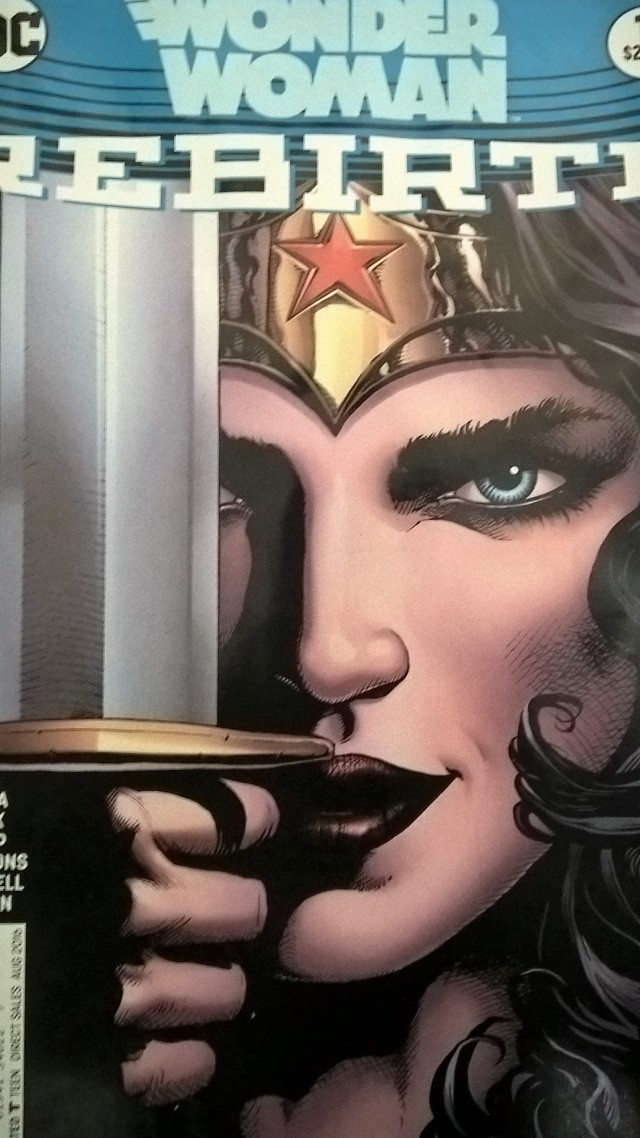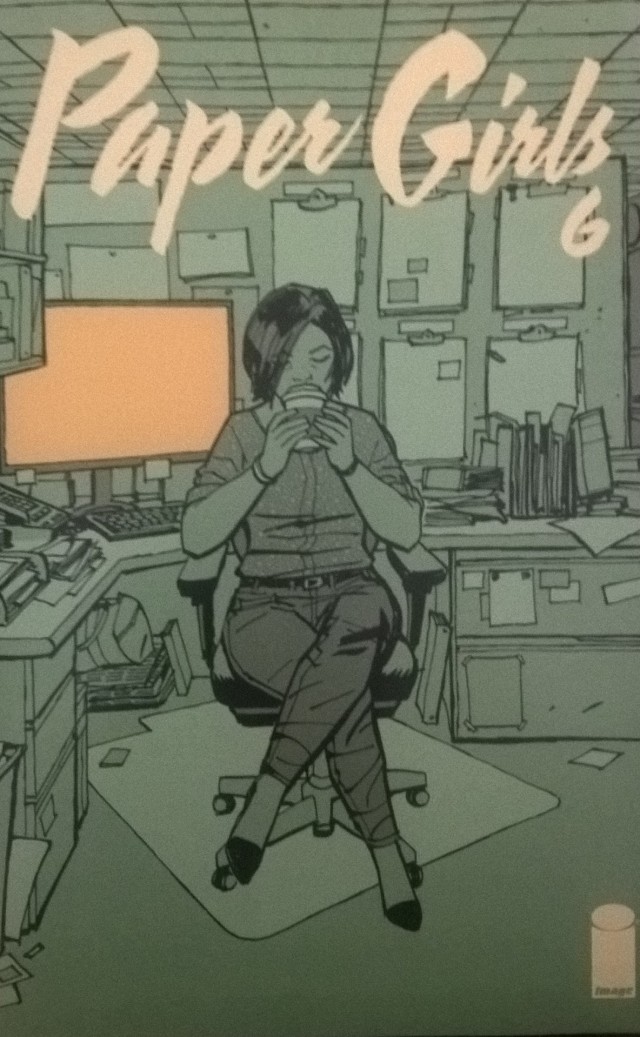By Marjane Satrapi

Telling off some European girls for making fun of Satrapi for being Iranian – p. 197
I fully believe humans have not inherently changed over the centuries. I also believe that humans are the same across cultures. I don’t mean to say that we all think the same, have the same ideals, or even want the same things, but that we are all struggling, growing, and trying to find our individual place within our cultural environment. Persepolis solidified these feelings for me. In her introduction Satrapi states, “I believe that an entire nation should not be judged by the wrongdoings of a few extremists.” Satrapi, through an autobiography of growing up in Iran (and Europe) during the Iranian/Islamic Revolution (1979) and Iran-Iraq War, she shows the humans involved in their fight for freedom and her interpretations of the world as a child and teenager. I really enjoyed this perspective, as I felt it was an authentic representation of some groups of people who opposed the Islamic Revolution and found ways to quietly, or loudly, oppose the Islamic extremists.
Marjane Satrapi led an eventful life as she watched her beloved country change in basically one year and then continue to become more and more fundamentalist as she became more liberal during her teenage years and early twenties. Before the Islamic Revolution, she went to a French school in Iran. Her parents were progressive and wanted her to be well educated. After the Islamic Revolution, universities were closed for two years to “revamp” the educational system to fit Islamic ideals and women were forced to wear a head covering or risk being harassed or arrested. Anyone who did not strictly follow the new Islamic guidelines for the country were arrested, and many were killed.
Satrapi’s first major encounter with harassment regarding the veil was when her mother’s car broke down. While her mother was waiting to be picked up by her husband, two “bearded guys” (synonymous with Islamic fundamentalist men in this book) indicated that women like her (those not wearing the veil) needed to be raped and thrown in the garbage. I find this absolutely abhorrent. I cannot understand how they believe that a woman not wearing a veil should be treated like that. Though, I guess I shouldn’t really be surprised. Some men even in non-Islamic countries try to tell women how to dress, lest they “tempt the man into sin,” rather than teaching men how to respect women and their bodies. Women are always at risk of being raped, and for some reason, the Iranians believed a head scarf would better “protect” them, just like “dressing modestly” is supposed to prevent women from being raped elsewhere. Apparently, if you’re not wearing a veil or you’re not completely covered, then you’re “asking for it.”

Watching the TV – p. 74
On the other hand, Satrapi makes an observation later in the graphic novel that makes more sense for the Islamic fundamentalists to have women wear head coverings and adhere to a nearly impossible dress code. She states, “The regime had understood that one person leaving her house while asking herself: ‘Are my trousers long enough?’ ‘Is my veil in place?’ … ‘Are they going to whip me?’ no longer asks herself: ‘Where is my freedom of thought?’ ‘Where is my freedom of speech?’ … It’s only natural! When we’re afraid, we lose all sense of analysis and reflection, our fear paralyzes us … Fear has always been the driving force behind all dictators’ repression. Showing your hair or putting on makeup logically became acts of rebellion” (302). Therefore, the Islamic Revolution, according to this graphic novel, is using the head covering as a way to strike fear into the citizens and to locate dissenters. I truly felt bad for all the progressive Iranians who lived and are living in Iran. Some try to leave, but they have to hope that the Visa will go through and they can escape.

Advice from her beloved grandmother – p. 150
The story is divided into three main story arcs. Marjane Satrapi as a child during the Islamic Revolution, her life in Europe during a majority of the Iraq-Iran War, and her life back in Iran after she is tired of being alone in Europe. She was sent to Europe because Satrapi’s parents believed it would be better for her to be away from the new regime and the danger of war. They raised her to be educated and think independently, Iran did not really allow that freedom. In Europe, she made some friends and some enemies. Satrapi spoke her mind and did not allow others to insult her heritage, or else she would fight back. This caused her to move around a lot and have to attend multiple schools. However, her most devastating moment was when she caught her boyfriend of two years, who she had doted on and left all her friends for, cheating on her with another woman. Along with having some arguments with her landlord around this time, she leaves and becomes homeless in Europe. Eventually, she managed to go back home to Iran and her family. She loves her family, deeply. She said that her time Europe was lonely and she almost wishes she had been able to stay in Iran during the war, if only to have her family by her side. Family and friends are important to most everyone across the world. We form bonds and relationships and want to experience life beside them.
I enjoyed that this autobiography was told using a simple black and white comic style. The style of art really helped lighten some of the horrible situations that the author endured. I learned a lot about the lives of some progressive Iranian Muslims and their ability to live through all sorts of torture and discrimination. I also saw the humanity in the novel. Humans can be vicious, cruel, and heartless toward one another, but they can also show love, humility, and compassion for each other. What I got from this story is that race, religion, or any other defining label should not matter in how we relate to one another. Humans are humans and we should treat each other with kindness and respect.


